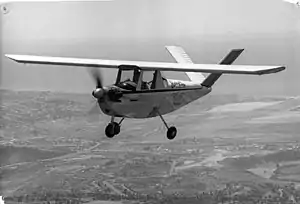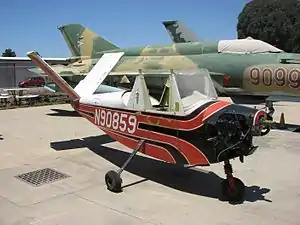| Honey Bee | |
|---|---|
 | |
| Honey Bee in flight | |
| Role | Homebuilt aircraft |
| National origin | United States |
| Manufacturer | Bee Aviation Associates, Inc. |
| Designer | Walter E. Mooney |
| First flight | 12 July 1952 |
| Introduction | 1952 |
| Number built | 1 |
The Beecraft Honey Bee was an all-metal V-tailed homebuilt aircraft, that was designed by Walter E. Mooney and first flown on 12 July 1952.[1]
Design and development
The Honey Bee was designed and built by Walter E. Mooney[2]
The Honey Bee is a single seat all metal, high-wing, tricycle gear-equipped aircraft with a V-tail. The stressed skin aircraft is designed to accommodate wing flaps and slots.[3]
The prototype was test flown by William Chana on 12 July 1952 and certified on 17 December 1953.[4]
Aircraft on display

Bee Aviation Honey Bee awaiting restoration at the San Diego Air & Space Museum
The Honey Bee prototype now is on display at the San Diego Air & Space Museum. It is the lone Bee aircraft to survive an arson fire at the museum.
Specifications (Honey Bee)
Data from Air Trails
General characteristics
- Crew: 1
- Length: 17 ft (5.2 m)
- Wingspan: 29 ft (8.8 m)
- Wing area: 95 sq ft (8.8 m2)
- Airfoil: NACA 4418
- Empty weight: 550 lb (249 kg)
- Gross weight: 860 lb (390 kg)
- Powerplant: 1 × Continental A-65 , 65 hp (48 kW)
- Propellers: 2-bladed
Performance
- Maximum speed: 100 kn (120 mph, 190 km/h)
- Rate of climb: 1,100 ft/min (5.6 m/s)
- Wing loading: 8.95 lb/sq ft (43.7 kg/m2)
- Power/mass: 13.25lb/hp
References
- ↑ Air Trails: 76. Winter 1971.
{{cite journal}}: Missing or empty|title=(help) - ↑ "Bee Aviation Associates". Retrieved 8 February 2012.
- ↑ "Sweet Little Plane". Flying: 53. October 1952.
- ↑ The Aeroplane, Volume 86. p. 222.
External links
![]() Media related to Beecraft Honey Bee at Wikimedia Commons
Media related to Beecraft Honey Bee at Wikimedia Commons
This article is issued from Wikipedia. The text is licensed under Creative Commons - Attribution - Sharealike. Additional terms may apply for the media files.